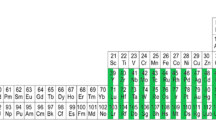Abstract
The Fibonacci diatomic array of this paper is a self-generating array which begins with two rows, each containing two 1’s; each row begins and ends with two 1’s. Each interior element in each row is in row (n - 1) or else is the sum of two adjacent elements in row (n - 2), according as the column number is of the form a p or b p , where (a p , b p ) is a Wythoff pair. The Fibonacci diatomic array counts the number of Fibonacci representations R(N) of non-negative integers N. It is also possible to generate the Fibonacci diatomic array from a single row of two 1’s, or to use a single row of two 1’s to generate either the odd rows or the even rows of the array. Both the array of Fibonacci representations and the Fibonacci diatomic array of this paper illustrate many known identities relating to Fibonacci representations while suggesting new identities.
Access this chapter
Tax calculation will be finalised at checkout
Purchases are for personal use only
Preview
Unable to display preview. Download preview PDF.
Similar content being viewed by others
References
Bicknell-Johnson, M. and Fielder, D.C. “The Number of Representations of N Using Distinct Fibonacci Numbers, Counted by Recursive Formulas.” The Fibonacci Quarterly, Vol. 37.1 (1999) : pp. 47–60.
Carlitz, L. “Fibonacci Representations.” The Fibonacci Quarterly, Vol. 6.4 (1968): pp. 193–220.
Hoggatt, V.E. Jr. and Bicknell, M. “A Generalization of Wythoff’s Game.” The Fibonacci Quarterly, Vol. 17.3 (1979): pp. 198–211.
Horadam, A.F. “Wythoff Pairs.” The Fibonacci Quarterly, Vol. 16.2 (1978): 147–151.
Kimberling, C. “The Zeckendorf Array Equals the Wythoff Array.” The Fibonacci Quarterly, Vol. 33.1 (1995): pp. 3–8.
Klarner, D.A. “Partitions of N into Distinct Fibonacci Numbers.” The Fibonacci Quarterly, Vol. 6.4 (1968): pp. 235–44.
Lang, W. “The Wythoff and the Zeckendorf Representations of Numbers are Equivalent.” Applications of Fibonacci Numbers. Volume 6. Dordrecht: Kluwer, 1996, pp. 321–37.
Sloane, N.J.A. “On-Line Encyclopedia of Integer Sequences.” http://www.research.att.com/~njas/sequences/.
Editor information
Editors and Affiliations
Rights and permissions
Copyright information
© 2004 Springer Science+Business Media Dordrecht
About this paper
Cite this paper
Bicknell-Johnson, M. (2004). The Fibonacci Diatomic Array Applied to Fibonacci Representations. In: Howard, F.T. (eds) Applications of Fibonacci Numbers. Springer, Dordrecht. https://doi.org/10.1007/978-0-306-48517-6_5
Download citation
DOI: https://doi.org/10.1007/978-0-306-48517-6_5
Publisher Name: Springer, Dordrecht
Print ISBN: 978-90-481-6545-2
Online ISBN: 978-0-306-48517-6
eBook Packages: Springer Book Archive




